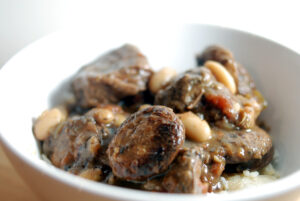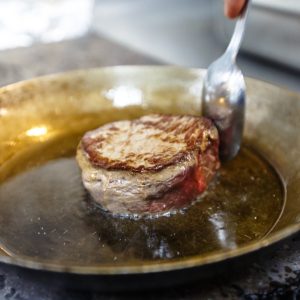How to Make a Great Beef Stew
Beef stew is comfort food; every spoonful tells a story of tradition, warmth, and family gatherings. Our recipe epitomizes classic, slow-cooked perfection—a dish lovingly prepared in kitchens worldwide for generations. This stew brings together tender chunks of beef, hearty vegetables, and a rich, savory broth to create a meal that is as nourishing as it is delicious.
The magic of beef stew lies in its simplicity and the depth of flavor that develops over time. Using fresh, quality ingredients and allowing them to meld together slowly creates a symphony of tastes and textures that will satisfy even the most discerning palate. The key is in the details: perfectly seared beef that locks in flavor, a medley of root vegetables that offer sweetness and earthiness, and a broth infused with herbs and spices that ties everything together.
Whether you’re looking to create a cozy meal for a chilly evening or seeking a dish that will bring your family together around the table, this recipe is the perfect choice. Join us on a culinary journey that promises warmth, comfort, and a taste of home with every bite.
Beef stew is a culinary staple with a rich history that spans cultures and centuries. It evolved into the beloved dish we know today. Its origins can be traced back to ancient times, when early humans discovered the benefits of slow-cooking meat and vegetables over a fire, enhancing flavors and tenderizing tougher cuts of meat.
The concept of stew is universal, and many cultures have developed their own versions. In medieval Europe, stews were common among peasants, who simmered meats with available vegetables and grains.
The French boeuf bourguignon, a sophisticated stew with beef braised in red wine, exemplifies how stew evolved into a gourmet dish. Meanwhile, Irish stew, traditionally made with lamb or mutton, potatoes, onions, and sometimes carrots, became a national dish symbolizing simplicity and heartiness.
In the Americas, beef stew gained popularity among early settlers and pioneers who relied on it as a nourishing and practical meal. The dish’s adaptability allowed it to incorporate regional ingredients, leading to various local versions. For instance, a thickened beef stew known as “Yankee pot roast” became New England’s traditional Sunday dinner staple.
Throughout its history, beef stew has remained a symbol of comfort and sustenance, cherished for its ability to bring people together and its flexibility to accommodate diverse ingredients and cooking methods. This enduring popularity underscores the stew’s role as a cultural and culinary mainstay in kitchens worldwide.
When making beef stew, choosing the proper cut of beef is crucial for achieving tender, flavorful results. Here are some of the best cuts to consider:
- Chuck roast or chuck steak is a popular choice for beef stew. It’s well-marbled with fat and connective tissue, which breaks down during slow cooking, resulting in tender, juicy meat and a rich broth.
- Bottom round or top round are leaner cuts of beef that can still be used for stew, though they may require longer cooking times to become tender. They offer a leaner option while still providing good flavor.
- Brisket is another flavorful cut that benefits from slow cooking. It has a good amount of fat, which adds richness to the stew, but it can be a bit tougher, so it’s essential to cook it low and slow until it becomes tender.
- Beef short ribs are a decadent option for beef stew. When braised, they offer incredibly rich flavor and a meltingly tender texture. They’re typically cut into smaller pieces for stew, adding a luxurious touch to the dish.
- Beef shank is a less common but wonderfully flavorful cut that works well in stew. It’s a bit tougher and contains much connective tissue, but it becomes incredibly tender when simmered and adds depth to the stew’s broth.
Ultimately, the best cut of beef for your stew depends on personal preference and availability. Experimenting with different cuts can also add variety to your stew-making repertoire.
Beef Stew
Ingredients
- 8 slices bacon
- 2½ pounds beef chuck boneless, cut into 1-inch pieces
- salt & pepper to taste
- 1 large onion chopped
- 3 leeks chopped, well rinsed - use white part & 1 inch of the green
- 6 carrots peeled & cut into 1½ inch julienne
- 2 turnips peeled and cut into pieces
- 2 teaspoons sugar
- 2½ cups beef stock
- 2½ cups red wine drinkable wine
- 2 tablespoons tomato paste
- 2 tablespoons butter
- 2 tablespoons red currant jelly
- 1 tablespoon fresh rosemary finely chopped
- 2 cups pearl onions red or white
- 8 ounces mushrooms sliced - wild if available
- 10 red new potatoes quartered
- 6 cloves garlic minced
- 4 sprigs fresh flat leaf parsley chopped
Instructions
- Cook the bacon in a large saute pan until the fat is rendered. Remove the bacon and transfer to a large heavy bottomed pot with a tight fitting lid. (approximately 5-6 quarts)
- Saute the beef in the same pan until all sides are browned. don't crowd the beef or it will steam the meat and not brown properly, so cook it in batches if necessary.
- Season with a little salt and pepper. When finished, transfer to your large cooking pot.
- Add the onions, leeks, carrots, and turnips to the saute pan, add sugar and cook over medium-high heat for approximately 8 minutes. Remove the vegetables and reserve in a large bowl.
- Add the butter to the saute pan and saute the mushrooms over medium high heat for approximately 10 minutes. Transfer to the reserved vegetables.
- Add the wine to deglaze the saute pan. Be careful when doing this.
- Add the beef stock and whisk in the red currant jam, tomato paste, ½ the chopped parsley and rosemary. Cook for a couple of minutes.
- Add to the pot with the meat and bacon.
- Add the poatoes and garlic to the meat, bacon and cooking liquid. Bring to a boil, cover and simmer for 45 minutes.
- Serve using the remaining parsley for garnish.

















4 Responses
This beef stew is really great but so are all of the recipes and ideas you dispense. I have been visiting this site for some time now and I love sharing your Facebook posts to my fan page, my fans get to see all your posts.
I am in the process of creating my blog and I sincerely hope I can get it to the standard you maintain here at The Reluctant Gourmet. I’m a big FAN!
Thank you so much Elizabeth for your kind comments. Let me know when your blog is up so I can check it out and share with my readers.
Best beef stew I’ve ever made. I get recipe requests every time I make it.
Thanks, Courtney. Glad you like it.